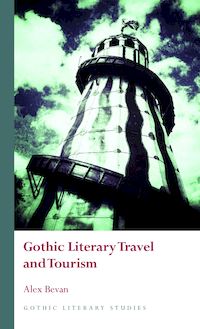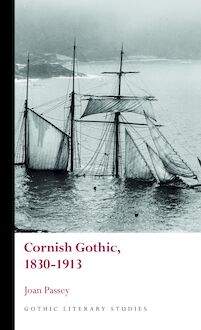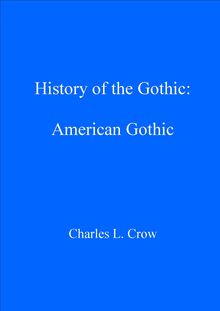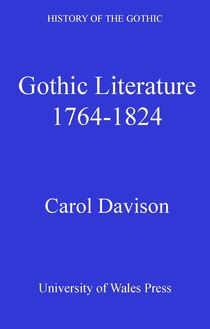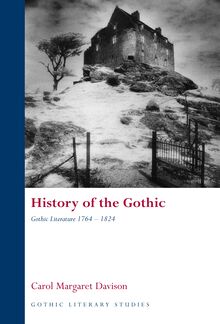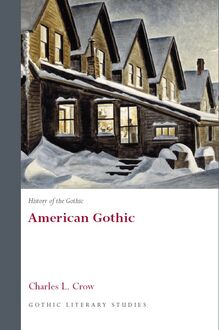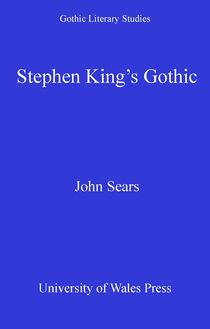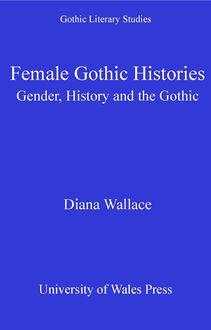-
 Univers
Univers
-
 Ebooks
Ebooks
-
 Livres audio
Livres audio
-
 Presse
Presse
-
 Podcasts
Podcasts
-
 BD
BD
-
 Documents
Documents
-
- Cours
- Révisions
- Ressources pédagogiques
- Sciences de l’éducation
- Manuels scolaires
- Langues
- Travaux de classe
- Annales de BEP
- Etudes supérieures
- Maternelle et primaire
- Fiches de lecture
- Orientation scolaire
- Méthodologie
- Corrigés de devoir
- Annales d’examens et concours
- Annales du bac
- Annales du brevet
- Rapports de stage
La lecture à portée de main
Vous pourrez modifier la taille du texte de cet ouvrage
Découvre YouScribe en t'inscrivant gratuitement
Je m'inscrisDécouvre YouScribe en t'inscrivant gratuitement
Je m'inscrisEn savoir plus
Vous pourrez modifier la taille du texte de cet ouvrage
En savoir plus

Description
Gothic tourism is a growing phenomenon and a medium through which Gothic fictions and folkloric tales are re-imagined and generated. This book examines the complex relationship between contemporary English Gothic attractions and storytelling, uncovering how works of Gothic fiction can both inspire Gothic tourism and emerge from the spaces of Gothic tourism, contending that Gothic tourist attractions are multi-layered storytelling experiences. Contributing to the study of literature and place, Gothic Literary Travel and Tourism draws together the study of literary Gothic tourism and spatial philosophy, offering interdisciplinary analysis into the interface between Gothic narrative(s) and the spaces in which the tourist navigates. The storytelling practices taking place in Gothic caves, theme parks, ghost tours and rural walks serve to reflect contemporary fears and anxieties. This book situates the act of touring a Gothic site as a process of literary and social discovery.
Dedication
Acknowledgements
Introduction
Part One: Theme Park Gothic
1. Scare Mazes
2. Gothic Attractions
Part Two: Guided Gothic Tours
3. Ghost Walks
4. Cave Tours
Part Three: Self-Guided Gothic Walks
5. Rural Ghost Walks
6. The Lancashire Witches Walk
Conclusion
Notes
Bibliography
Index
Sujets
Informations
| Publié par | University of Wales Press |
| Date de parution | 15 mai 2023 |
| Nombre de lectures | 0 |
| EAN13 | 9781786839961 |
| Langue | English |
Informations légales : prix de location à la page 0,4700€. Cette information est donnée uniquement à titre indicatif conformément à la législation en vigueur.
Extrait
GOTHIC LITERARY TRAVEL AND TOURISM
SERIES PREFACE
Gothic Literary Studies is dedicated to publishing groundbreaking scholarship on Gothic in literature and film. The Gothic, which has been subjected to a variety of critical and theoretical approaches, is a form which plays an important role in our understanding of literary, intellectual and cultural histories. The series seeks to promote challenging and innovative approaches to Gothic which question any aspect of the Gothic tradition or perceived critical orthodoxy. Volumes in the series explore how issues such as gender, religion, nation and sexuality have shaped our view of the Gothic tradition. Both academically rigorous and informed by the latest developments in critical theory, the series provides an important focus for scholarly developments in Gothic studies, literary studies, cultural studies and critical theory. The series will be of interest to students of all levels and to scholars and teachers of the Gothic and literary and cultural histories.
SERIES EDITORS
Andrew Smith, University of Sheffield
Benjamin F. Fisher, University of Mississippi
EDITORIAL BOARD
Kent Ljungquist, Worcester Polytechnic Institute Massachusetts
Richard Fusco, St Joseph’s University, Philadelphia
David Punter, University of Bristol
Chris Baldick, University of London
Angela Wright, University of Sheffield
Jerrold E. Hogle, University of Arizona
For all titles in the Gothic Literary Studies series visit www.uwp.co.uk
Gothic Literary Travel and Tourism
Alex Bevan
© Alex Bevan, 2023
All rights reserved. No part of this book may be reproduced in any material form (including photocopying or storing it in any medium by electronic means and whether or not transiently or incidentally to some other use of this publication) without the written permission of the copyright owner except in accordance with the provisions of the Copyright, Designs and Patents Act. Applications for the copyright owner’s written permission to reproduce any part of this publication should be addressed to the University of Wales Press, University Registry, King Edward VII Avenue, Cardiff CF10 3NS.
www.uwp.co.uk
British Library Cataloguing-in-Publication Data
A catalogue record for this book is available from the British Library.
ISBN 978-1-78683-994-7
eISBN 978-1-78683-996-1
The right of Alex Bevan to be identified as author of this work has been asserted in accordance with sections 77 and 79 of the Copyright, Designs and Patents Act 1988.
The publisher has no responsibility for the persistence or accuracy of URLs for any external or third-party internet websites referred to in this book, and does not guarantee that any content on such websites is, or will remain, accurate or appropriate.
Cover image © Clare / Stockimo / Alamy Stock Photo
For my husband, Tom
C ONTENTS
Acknowledgements
Introduction
Part One: Theme Park Gothic
1 Scare Mazes
2 Gothic Attractions
Part Two: Guided Gothic Tours
3 Ghost Walks
4 Cave Tours
Part Three: Self-Guided Gothic Walks
5 Rural Ghost Walks
6 The Lancashire Witches Walk
Conclusion
Notes
Bibliography
A CKNOWLEDGEMENTS
The research underpinning this book began when I was a postgraduate student at the University of Lincoln, and I extend my sincere thanks to the university for the research funding that I received to pursue this project. Special thanks are owed to my former supervisor Professor Lucie Armitt for her unwavering support, careful guidance and superb feedback on my research to date. I also thank Professor David Punter for his kind and insightful feedback on this research and for his continued academic support.
I am thankful for the stimulating conversations that arose from the ‘Gothic Migrations’ conference (International Gothic Association, Vancouver, 2015): ‘Haunted Europe: Continental Connections in English-Language Gothic Writing, Film and New Media’ conference (Leiden University, 2016) and the ‘Supernatural Cities’ symposium (University of Portsmouth, 2016). The interesting feedback and advice that I received at these events has helped to shape the direction of this book. Thanks are also due to the master’s students I taught on the ‘Gothic Spaces’ module (2015–16) for their creative and thought-provoking responses to the ‘Subterranean Gothic’ and ‘Lincoln Gothic’ seminars that I co-delivered.
I would like to express my gratitude to Dame Professor Carol Ann Duffy for very kindly giving her permission for me to cite her poem ‘The Lancashire Witches’ (2012) in this book. Thank you also to Palgrave Macmillan for granting permission to reproduce my chapter ‘Walking with the Lancashire Witches’, which was originally published in The Palgrave Handbook of Contemporary Gothic , edited by Clive Bloom (Basingstoke: Palgrave Macmillan, 2020). Thank you also to Sarah Lewis, head of commissioning at the University of Wales Press, for her guidance during the production of my book proposal and for her enthusiasm and interest in this project.
Thank you to my parents, Dianna Bevan and Christopher Bevan, for their ongoing support, love and encouragement. Particular thanks to Mum for her insightful responses to Scarefest and Alton Towers. And, last but not least, I dedicate this book to my husband and best friend, Thomas Mawe, for not only accompanying me on my research visits and being my travel companion, but for being a source of strength and happiness throughout my academic career.
Introduction
Thousands of tourists flocked to the British Library in London from 3 October 2014 to 20 January 2015 for the exhibition ‘Terror and Wonder: The Gothic Imagination’ and to celebrate the 250-year anniversary of Horace Walpole’s The Castle of Otranto (1764). 1 Curated by Tim Pye, the exhibition enabled visitors to view ‘two hundred rare objects [and] trace 250 years of the Gothic tradition [while] exploring our enduring fascination with the mysterious, the terrifying and the macabre’. 2 Featuring a spectral, bare-footed woman in a white dress creeping towards the British Library in the dead of night (accompanied by chilling background music), the video trailer for the exhibition (featured on the British Library website) was not dissimilar from a horror-film trailer, generating the expectation that this event would be more than a literary/art exhibition – it would be a Gothic experience. I visited the exhibition on 19 January 2015 and had the pleasure of meandering through the literary Gothic worlds of many great Gothic authors of the past two-and-a-half centuries. While the exhibition showcased original manuscripts and first editions of many famous Gothic literary works, the experience also displayed more unusual objects, such as a Victorian vampire slaying kit (found in the Dracula room), demonstrating the broad spectrum of recognisable literary Gothic cultural artefacts. Visitors were also afforded the opportunity to view clips from classic Gothic films such as Nosferatu (1922) directed by F. W. Murnau. I recall gathering in front of the looping video clip alongside the other artefacts, recognising the dynamic storytelling experience being created through the exhibition’s use of mixed media. The closing room of the exhibition was framed around Gothic subcultures and it contained an array of photographs of the ‘Whitby Goth Weekend’ taken by Martin Parr, alongside extravagant Gothic costumes displayed in large glass cabinets. We learnt that these were the costumes once worn by attendees to this biannual event held in Whitby, North Yorkshire. The exhibition was the largest celebration of the Gothic mode in history, marking the twenty-first-century cultural investment in all things Gothic. Employing the language of literary Gothic tourism, The Guardian described the exhibition as an ‘epic journey through a literary genre and its endless cultural transformations’. 3 During my immersive literary tour through the history of the Gothic, I realised that the ‘Terror and Wonder’ exhibition was, perhaps, the most significant working example of literary Gothic tourism – in its purest sense – to date. The exhibition showcased the multifaceted workings of literary Gothic tourism, as tourists wandered through various spaces – both dedicated to and inspired by – all manner of Gothic narratives. Testament to the appetite for literary Gothic tourism, the exhibition was immensely popular, offering ‘extra late-night openings owing to popular demand’, demonstrating the widespread contemporary desire to immerse oneself physically into literary Gothic spaces. 4
I will begin Gothic Literary Travel and Tourism by exploring how I define the term ‘literary Gothic tourism’. The Gothic is recognised as a mode of literature that ‘exceeds genre and categories, restricted neither to a literary school nor to a historical period’. 5 In this book, I shall demonstrate how the untamed Gothic mode extends its fictions into the contemporary spaces of Gothic tourism. There is a long-standing relationship between the Gothic and place/space, as the Gothic mode is indebted to its origins found in Gothic architecture, evidenced most explicitly by Walpole’s textual and spatial revival of the Gothic in The Castle of Otranto and his iconic Gothic revival building, Strawberry Hill, in London. Sara Wasson argues that the ‘Gothic mode [has] two core characteristics: a particular emotional colouring of the narrative filter, and a preoccupation with certain relationships to space’. 6 Given the Gothic’s investment in narrative and space, it is inevitable that the Gothic mode has begun to generate a literary-based Gothic tourism that is intrinsically connected to the literary world of storytelling. What separates Gothic Literary Travel and Tourism from other research into Gothic tourism (Inglis and Holmes: 2003; Gentry: 2007; McEvoy: 2010, 2014, 2015) is its dual spatial/literary methodological approach, which serves to chart the complex relationship between contemporary Gothic attractio
-
 Univers
Univers
-
 Ebooks
Ebooks
-
 Livres audio
Livres audio
-
 Presse
Presse
-
 Podcasts
Podcasts
-
 BD
BD
-
 Documents
Documents
-
Jeunesse
-
Littérature
-
Ressources professionnelles
-
Santé et bien-être
-
Savoirs
-
Education
-
Loisirs et hobbies
-
Art, musique et cinéma
-
Actualité et débat de société
-
Jeunesse
-
Littérature
-
Ressources professionnelles
-
Santé et bien-être
-
Savoirs
-
Education
-
Loisirs et hobbies
-
Art, musique et cinéma
-
Actualité et débat de société
-
Actualités
-
Lifestyle
-
Presse jeunesse
-
Presse professionnelle
-
Pratique
-
Presse sportive
-
Presse internationale
-
Culture & Médias
-
Action et Aventures
-
Science-fiction et Fantasy
-
Société
-
Jeunesse
-
Littérature
-
Ressources professionnelles
-
Santé et bien-être
-
Savoirs
-
Education
-
Loisirs et hobbies
-
Art, musique et cinéma
-
Actualité et débat de société
- Cours
- Révisions
- Ressources pédagogiques
- Sciences de l’éducation
- Manuels scolaires
- Langues
- Travaux de classe
- Annales de BEP
- Etudes supérieures
- Maternelle et primaire
- Fiches de lecture
- Orientation scolaire
- Méthodologie
- Corrigés de devoir
- Annales d’examens et concours
- Annales du bac
- Annales du brevet
- Rapports de stage

